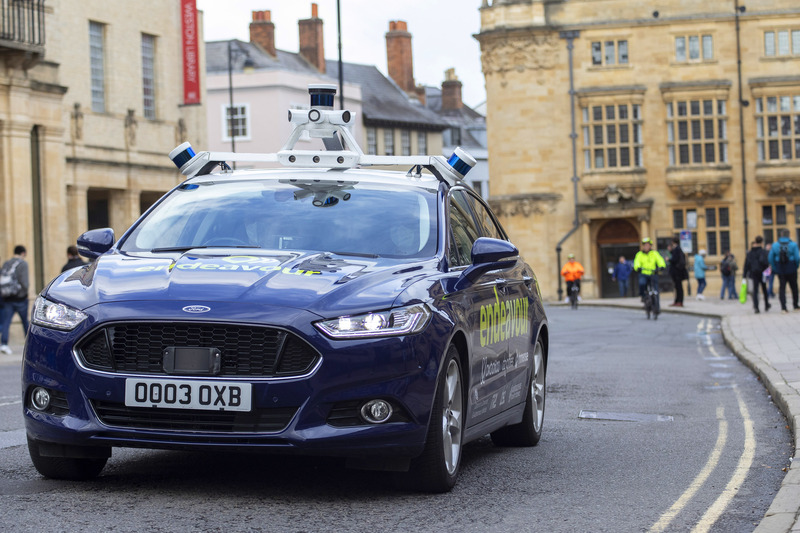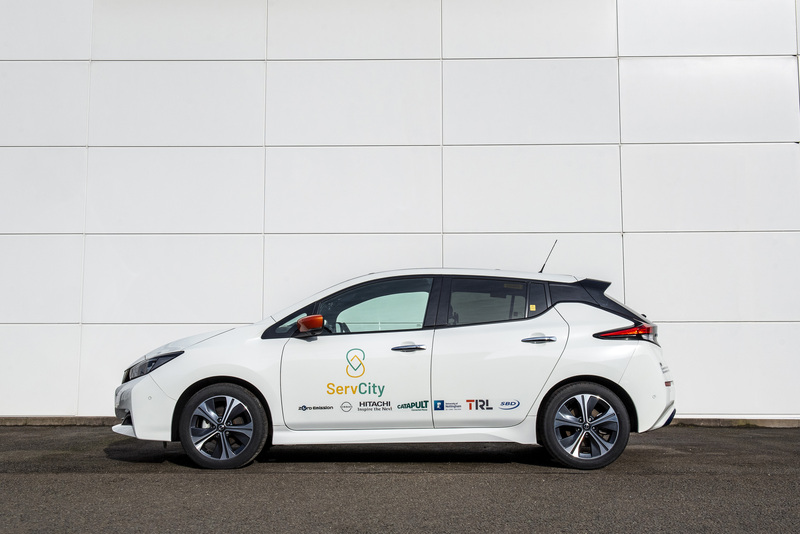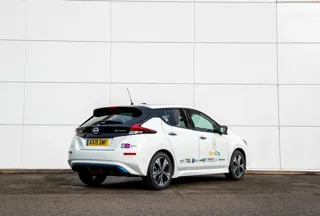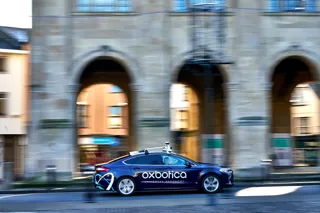This feature originally appeared in the January 2021 edition of Fleet News. Read the article in the digital issue of the magazine.

In many ways 2020 seemed like a year where time stood still, with the upheaval caused by the Covid-19 pandemic lockdowns either disrupting many plans or putting them on hold entirely.
One of the sectors affected was the UK’s connected and automated mobility (CAM) industry which saw its progress curtailed as organisations were forced to adopt different working practices.
Nevertheless, there were still advances made towards realising the promise of CAM in the UK, according to Mark Cracknell, head of technology at Zenzic.
“The UK is forging ahead with the development of key enabling technologies of connected and autonomous vehicles (CAVs) such as artificial intelligence (AI), cybersecurity and software, which leaves the country in a good position to double down on research and push on towards readying for deployment,” he says.
Key developments included the launch of multiple UK testbeds, such as London’s Smart Mobility Living Lab and Midlands Future Mobility, which provide a range of self-driving vehicle testing facilities, including controlled testing environments to fully-connected public roads.
On-road trials such as HumanDrive and Project Endeavour were also able to be carried out, either because they were before lockdown or appropriate social distancing measures were used.
“These on-road trials have delivered key learnings for the UK,” says David Webb, head of innovation at the Centre of Connected and Autonomous Vehicles (CCAV), a Government organisation responsible for allocating and managing £200 million of funding into the UK CAM ecosystem.
CCAV has funded around 80 projects in the past four years including feasibility studies, simulations an on-road CAV trials, with about 20 programmes left to run over the course of this year.
“We continue to test and deliver successful trials on some of Europe’s most complex roads, giving thousands of people experience and insight into autonomous technology and the services it could bring,” Webb adds.
“We’ve gained so much from the public’s input into these trials, especially around the perception of safety and how to ensure the services are accessible, inclusive and wanted.
“We have trialled – and we continue to trial – on-road, off-highway and off-road with a variety of vehicles showcasing the different services and solutions that CAV can provide in the future of transport.”
Key early autonomous vehicle (AV) projects included Project Venturer, which ran from July 2015 to July 2018 and involved operating fully autonomous vehicles on roads in Bristol and South Gloucestershire, and Project Gateway (October 2015 to March 2018), which enabled the public to take part in a driverless pod shuttle service trial around Greenwich.
First taste of AVs
“Venturer and Gateway gave the UK its first experiences of autonomous vehicles, not only the complexity of developing the self-driving vehicle, but highlighting at a very early stage the legal, regulatory and insurance hurdles we need to overcome,” says Webb.
“Gateway also saw more than 2,000 miles covered around the Greenwich Peninsula, tackling snow, pedestrians and pets without incident.
“Our following two trials – Project Driven (July 2017 to December 2019) and Streetwise (September 2017 to March 2020) – saw consortium partners showcase how their systems could handle the complexities of London’s roads.
“Both trials demonstrated AVs to more than 100 passengers each and, even in torrential downpours, the journeys were satisfyingly normal.”
Project Driven culminated in trials in and around London’s Queen Elizabeth Olympic Park to showcase co-operative communication between multiple automated vehicles, while Streetwise allowed passengers to experience a 13-mile return trip as an example of commuting in a self-driving vehicle.
Webb highlights two other trials which show how autonomous vehicles can operate on all road types: the Nissan-led HumanDrive and Aurrigo’s six-month project on the Blind Veterans UK facility near Brighton.
The charity helps veterans who return from combat with eyesight loss to rebuild their lives and the project saw around 420 passengers transported to destinations such as a church or to access leisure services in an autonomous pod.
“The residents really did feel as if the technology could help improve their well-being and independence in the future,” says Miles Garner, sales and marketing director for RDM Group, the parent company of Aurrigo.
“It was a really good trial and it makes you understand the reason why we are in this type of technology isn’t because we can actually do this technology, it’s because we can really help change people’s lives.”
Aurrigo focuses on developing autonomous vehicles for sites such as campuses, airports and shopping malls.
It also deployed an AV to transport golfers and caddies from the clubhouse to the first tee at last year’s Welsh Open tournament at Celtic Manor.
“The question which is often asked is ‘where will autonomous vehicles actually make the biggest impact’,” says Garner.
“Our prediction is that we’ll be seeing them on longer-distance, high-speed environments similar to the Otto truck trials on the highways in America, and also for the shorter distance, low-speed environments like airports and campuses.”

Blueprint for AVs
The HumanDrive project ran from July 2017 to March 2020 and culminated in a 230-mile journey between Cranfield and Sunderland which saw a modified Nissan Leaf electric cover 99% of the trip in fully autonomous mode.
The experience acquired through this project will be leveraged by the ServCity programme’s five partners – Nissan, Connected Places Catapult, TRL, Hitachi and the University of Nottingham – to ferry passengers on public London roads in self-driving Leaf cars.
The 30-month project, which started this month, will use a combination of test simulation, end-user research and real-world trials to develop a
blueprint to tackle the barriers to deploying AVs in cities.
“This project, backed by Government funding, will not only help make AVs more user-friendly, but also gives users confidence that they can respond quickly and safely and to all types of challenges they face on the roads,” says business and industry minister Nadhim Zahawi.
“If society is to enjoy the benefits of self-driving vehicles , we need to ensure the technology can safely master a complex and lively modern city, with all its obstacles.”
Another trial taking place this year is also aiming to build on the success of a previous initiative.
Oxbotica, which was a leading organisation in Project Driven, is one of five partners in Project Endeavour (see panel below) which is designed to help scale and accelerate the deployment of AVs by focusing on four themes:
* Running four trials/demonstrations of AVs on public roads across multiple cities in the UK.
* Working with local authorities to help them understand the technology and what they need to do to deploy AVs on their streets.
* Carrying out research with the public to understand attitudes towards AV technology and related services.
* Developing and refining safety assurance methodology.
“Ongoing trials of connected and automated vehicles in the UK pave the way for more efficient use of our roads, especially important given the importance of home delivery for goods and groceries,” says Cracknell.
“The trials happening in 2021 should encourage all local authorities to think about CAV blueprints and how they fit into plans around sustainability and mobility.
“It is important that by the end of the year, they have started to map out how CAM will integrate into their existing transport plans and work together to find common approaches. This is an industry with immense possibility and month-by-month the possibilities come closer to reality.”
Autonomous buses to provide regular 30-mile service
Paying passengers will travel across the Forth Bridge this year in autonomous buses under the CAVForth trial.
The project is being led by Fusion Processing and will see five 42-seat buses operating on a 30-mile route between Fife and the Edinburgh Park train and tram interchange at speeds of up to 50mph.
With services every 20 minutes between 6am and 9pm, the buses could transport 10,000 passengers each week.
They are fitted with Fusion Processing’s CAVstar control and sensing system, integrated with the buses’ steering, throttle and braking system. They draw information from radar, lidar, optical cameras and ultrasonic sensors, along with sat-nav, to detect and avoid objects in all weathers and light conditions.
The buses will operate at level four autonomy, which means they will drive autonomously along the routes and, while there will be regular driver controls, the driver will not be expected to use them other than in an emergency.
The project follows a live trial of the CAVstar system in a Stagecoach bus in 2019 which navigated its way autonomously around the group’s Manchester depot, visiting a fuelling station and the bus wash before finding its parking spot.
The project is part-funded by CCAV with the project consortium comprising Fusion Processing, Alexander Dennis, Stagecoach Group, Transport Scotland, Napier University and Bristol Robotics Laboratory.
Q&A: Graeme Smith, consortium leader for Project Endeavour and senior vice-president, Oxbotica

What is Project Endeavour?
Project Endeavour is the UK’s first multi-city demonstration of AVs and is jointly funded by industry and Government.
The consortium has built six self-driving vehicles, based on Ford Mondeos, and we started our first public loop in Oxford in November.
We’ll be running trials there for the next five or six months. In the spring we’ll set up another route, this time in Greenwich, and then a second route in Greenwich.
Then, finally, we’ll be looking to deploy in a completely new city, possibly somewhere like Birmingham or Manchester.
Who are the consortium partners?
We (Oxbotica) are providing the autonomous vehicle software and the vehicles for the trials. Immense is providing citywide AV simulations and DG Cities is working together with Oxfordshire County Council to help us develop and refine engagement models with local authorities. Finally, we have partners like TRL and BSI who are working on a safety assurance work package.
How do you ensure safety during trials?
When we do public trials we operate very conservatively and have a different philosophy to what we might have on the test track. All cars have safety drivers and they have very explicit instructions that if anything out of the ordinary is going on around them, they should intervene.
For example, if our car is passing a school at school leaving time and there’s lots of traffic and kids, why wouldn’t you tell your drivers to intervene?
If it is approaching a pedestrian crossing
and the driver sees somebody with headphones on, or they’re looking at their phone and not paying attention, we are not going to take any risks and the drivers are instructed to step in.
We are not going to take any risks with members of the public. That is ever so important to us.
When will AVs become a common sight in the UK?
When most people think about autonomy they think about passenger cars and, in reality, that’s many years away, maybe 10 or 15, maybe never.
We are a long, long way away from any vehicle that’s able to be autonomous anywhere in the world at any time.
Just because a vehicle can drive on the public road doesn’t mean it can drive on a construction site or a mine or under the sea.
Everything is restricted to a domain, so the answer to the question about when will we start to see this technology is not black and white because you can see autonomous systems happening around us already.
For example, London’s Docklands Light Railway has a driverless train. That’s in a very limited domain: it’s on a track, it doesn’t need maps to operate.
Over the next few years, we will start to see AVs being used in areas such as mining and construction.
There are also industrial environments that are simple and easy to operate in, and then there are areas not on public roads where you could use multi-people shuttles and these will start to happen in the next five or so years.
After that, maybe six or seven years, we’ll probably start seeing robotaxi-type vehicles operating in certain places, but it will be many years before the technology is ubiquitous.























Login to comment
Comments
No comments have been made yet.